![KeepCalmStudio.com-[Crown]-Keep-Calm-And-Use-Your-Soft-Skills (1)](http://melbourneplayback.com.au/cms/wp-content/uploads/2015/04/KeepCalmStudio.com-Crown-Keep-Calm-And-Use-Your-Soft-Skills-1-e1428358874358.png)
Did you see the article in The Age recently titled “The rise of soft skills: Why top marks no longer get the best jobs”? The journalist John Elder described how leading companies from Australia and the UK are valuing more than ever ‘soft skills’ in their workforce.
So what exactly are soft skills?
They are skills that build personal connection. Have you noticed how things are more likely to go our way when we are able to make a genuine connection with someone? Soft skills help us do that. They are skills in emotional intelligence, communication, conflict resolution and using collaboration (rather than compromise) to solve problems. Its something we can all relate to.
Soft skills really can be a game changer.
Associate Professor Jennifer George is director of a new masters program at Melbourne Business School that is offering business training that includes a soft skills program complete with actors from Melbourne Playback.
We join the participants for sessions in voice projection, posture and presentation skills. Later on we do ‘real-play’ sessions where our actors play scenarios with such as the boss who the participants have to break bad news to.
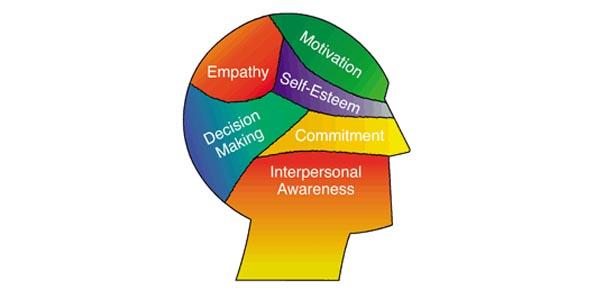
For skills that are inter-personal, there is no substitute for trying it out in a safe place, with an actor who isn’t actually your boss.
The ability to have a go, get feedback and have another go is invaluable as a way to learn these skills. They can’t be mastered by theory alone.
What soft skills do you want to master? You elevator pitch? Listening? Collaboration? Share them in the comments below.
And try this: ask a friend to have a go with you. Make up a scenario based on your target soft-skill, play it out together, talk about how it went and try again. Give yourself permission to do it really badly. Make it fun. You’ll be amazed how easy it becomes.
Read the full article from The Age here
Posted by Melbourne Playback in
News on 10 Nov 2014
by Karen Berger
Each year, Melbourne Playback Theatre is honoured to be invited to perform at a number of gatherings for refugees and recent immigrants. In 2014 these included:
- performances and workshops organised through SEAAC (Southern Ethnic Advisory and Advocacy Council)
- a performance at Maribyrnong Immigration Detention Centre
- a performance for Whittlesea Interfaith Network
- a Refugee Week performance at Footscray Community Arts Centre organised through the Ethnic Communities Council of Victoria.
We started wondering: ‘How well are we serving the refugee and immigrant community through these shows?’ There are a number of company members who are immigrants to Australia, and two whose parents were refugees, but still we felt there was a lot more for us to learn. For example: What is the best way for a conductor/facilitator to invite people to share their stories in this situation?
As a result, on July 28th 2014, we organized a special rehearsal where people from refugee and immigrant backgrounds were invited to our North Fitzroy rehearsal space to share their stories and to then give us feedback on how we were doing. We were extremely lucky that these 8 generous and engaging people (children and adults from Afghanistan, Iran, South Sudan and Ethiopia) donated their time and knowledge to help us improve our work.
These are some of the thoughts that came up:
- Why do we all wear black in performances? In many cultures wearing black is associated with mourning. (In Vietnam white is worn at a funeral.)
- What are the other ways we could explain how a Playback show works before starting?
- Can the company develop more expertise in ethnic dance and music (and food etc)?
- Refugees and immigrants want to be first seen as people before they’re categorised by where they’re from. It’s important to hear funny as well as sad stories – and stories about everyday life.
Overall it was a very moving evening. A Sudanese guest related that she had thought that after years of living in refugee camps, she would be inured to the pathos of another ‘refugee story’. However she found the details and playing back of specific stories to make them emotionally engaging.
There was acknowledgement of the healing, dignifying and hope-building power of telling a story, and that Playback can offer a wonderful service to people from challenging backgrounds.
We are continuing to develop our expertise in this area and are currently organising to meet with the manager of the Victorian Foundation for Survivors of Torture to learn more about how Melbourne Playback can best serve storytellers with traumatic stories.
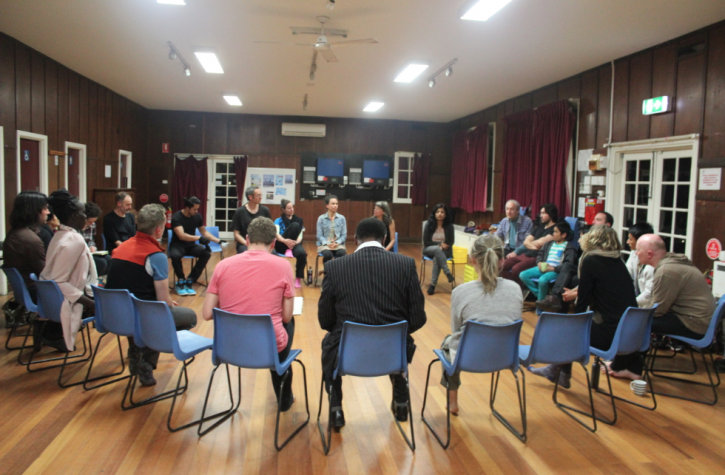
Melbourne Playback rehearsal exploring our approach to the ‘refugee story’.
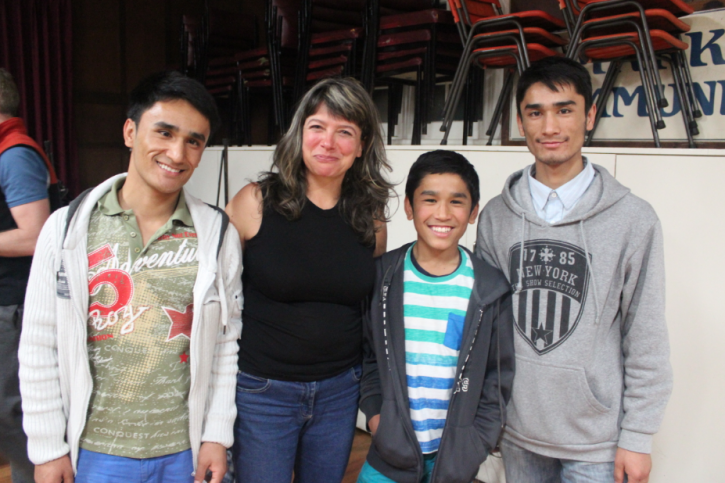
Melbourne Playback’s Karen Berger with the Aminullah brothers.
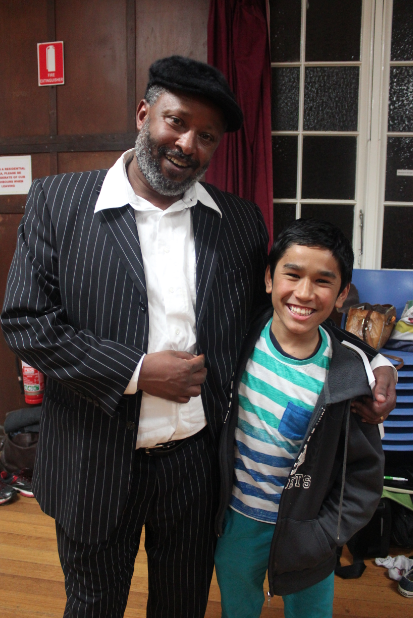
Tesfaye G/Hana and Mustafa Aminullah
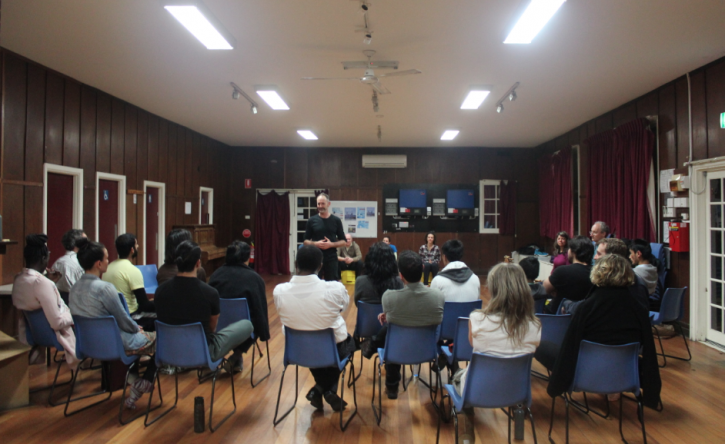
Melbourne Playback rehearsal exploring our approach to the ‘refugee story’.
by Alex Sangster.
“A culture cannot evolve without honest, powerful storytelling”
Robert McKee
Once upon a time there was a leader who wanted to share a vision……
Once upon a time there was a pioneer who wanted to take her people out into wild new wonderlands…
Once upon a time there was an exhausted company manager who really wanted to find a way to get his people on board with the new branding…
Telling stories matters and telling stories well isn’t something that just happens. Melbourne Playback is all about opening people up to their untapped potential as storytellers so that the message of their brand or the vision of their company, can be fully actualised.
In her recent book ‘Gossip from the Forest’ looking at how telling stories are one of our earliest cultural forms, Sarah Maitland argues that;
“The whole tradition of [oral] story telling is endangered by modern technology. Although telling stories is a very fundamental human attribute, to the extent that psychiatry now often treats ‘narrative loss’- the inability to construct a story of one’s own life – as a loss of identity or ‘personhood,’
it is not natural but an art form — you have to learn to tell stories.
The well-meaning mother is constantly frustrated by the inability of her child to answer questions like ‘What did you do today?’ (to which the answer is usually a muttered ‘nothing’ – but the ‘nothing’ is cover for ‘I don’t know how to tell a good story about it, how to impose a story shape on the events’). To tell stories, you have to hear stories and you have to have an audience to hear the stories you tell.’
Melbourne Playback opens up space for people to hear stories – to really hear them. We also create a space where people begin to learn, not only that they do have powerful stories within them but also how to tell these stories to a community.
We know that stories help us navigate life’s complex social problems — that children learn about the world through listening to what happens, once upon a time, to wild wolves and brave girls. We also know that the ability to hold our personal story in the context of our culture’s meta narrative is profoundly empowering.
Jonathon Gottscall in his book ‘The Storytelling Animal’ draws on the latest research in neuroscience, psychology, and evolutionary biology to reveal to us what it means to be a storytelling animal. And he argues that ‘the more absorbed you are in a story, the more it changes your behavior. So if you are equipped to tell your story or the story of your organization and its vision well, then you are more likely to be able to initiate behavior and culture change’.
We also now know that our brains become more active when we tell stories.
And that we feel much more engaged when we hear a narrative about events. According to Uri Hasson from Princeton, a story is the only way to activate parts in the brain so that a listener turns the story into their own idea and experience.
He writes of how, rather than struggling with getting people on board with your projects and ideas, you should simply tell them a story. Research shows us that storytelling is the most effective way to plant ideas into other people’s minds.
Melbourne Playback has a proven track record in working with organizations to help them learn how to articulate their own story and to then dynamically share that story with the wider world.
Posted by Sheridan Green in
Tips on 21 Feb 2014
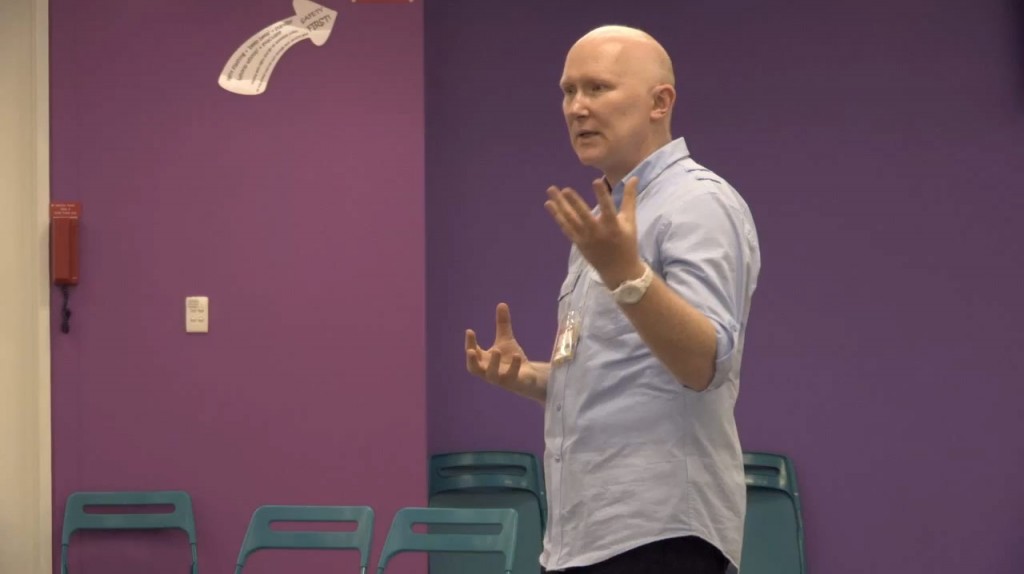
Ian David Melbourne Playback facilitator working with Qantas on presenting skills
Presenting to any sized audience can be daunting and fill you with anxiety. You are the focus. All eyes are on you. Expectations are high. Everything you say, everything you do, your appearance, your tone of voice, your gestures and the content of your presentation play a part in the efficacy of your delivery. Knowing what you want to say is only part of the whole equation. You want your presentation to have an impact and for the audience to remember the information.
The following techniques provide some suggestions on how to accomplish exceptional presentations. Melbourne Playback is offering Training Days in May and “Presenting with Confidence” and “Use Story to Communicate Vision” will support you to realise these concepts. More information and bookings go to www.melbourneplayback.com.au or email email hidden; JavaScript is required.
Know your audience
Whether you need to persuade or just inform, you need to understand a number of things about your audience. Who are they? Why are they there? How experienced are they? This helps you frame your content in a way that resonates most strongly with your audience.
Be an expert
No one likes to be told things that they already know. Know more than your audience. This means doing your homework and having evidence for your assertions. Be clear about how you arrived at your opinion.
Prepare your speech
This might feel like an obvious one. But so often, people have not written down what they are going to say. They have a few notes scribbled down on a bit of paper and suddenly in front of hundreds of people they can’t read their notes or understand what they were thinking in the first place. Writing down what you want to say before hand, even if you don’t read it while your up there, helps consolidate your thoughts and ideas. It can provide you with a structure about how you might approach your material.
Rehearse
Rehearse alone, in front of people, film it, record it – do it again and again and again. You need to know what is coming next. You need to know it inside out and back to front. You want it to be second nature. Once you think you cannot possibly do it again – do it again! Keep refining. Keep asking yourself; Is this clear? Does my presentation logically flow? Am I presenting in an engaging way? Am I waffling on? Remember; less is more.
Anecdotes are your friend
Inserting a personal story or a story that acts as an example is an excellent way of connecting with your audience. It makes complex concepts comprehensible. It does this by allowing the audience to use the imaginative side of their brain and understand the point of your presentation from a humanistic perspective. This increases their understanding about why your presentation is important.
Vocal Tone
You may have written and rehearsed the most exciting speech in history, but if you present it monotone, your audience will disengage. When we are speaking casually to our colleagues, friends or family we use lots of dynamic tones to emphasise a point or to help articulate the story we are telling. Sometimes this exciting dynamic voice disappears when we present. Nerves are usually the culprit. The first step to ensure that we speak with dynamic vocal tone is to be aware of our tendency to flatten tone. A good friend can help with this when they listen to you rehearse! Are you too loud? Too soft? Too monotone?
Body Language
We subconsciously read so much into the way people physically hold themselves. The best way to present is to make sure you are standing tall and relaxed – confident and open. Leave your arms on the podium or down by your sides when you are not using them to make gestures. Make sure your gestures are natural and spontaneous. Maintain eye contact. Make sure the clothes you choose to wear facilitate easy movement and do not distract from the incredible amount of work that you’ve put into this presentation.
Posted by Karen Berger in
Tips on 23 Jan 2014
At Melbourne Playback, we specialise in working on our communication skills – in our workshops, presentations, performances and rehearsals. How to develop your communication with your colleagues, employees and supervisors is one of the main skills we can offer to you and your organisation. We believe that there are four main areas to focus on:
- Awareness. Be present.
- Listen. Empathise. Understand the story.
- Be bold.
- Be generous. Make your partner look good.
AWARENESS
1. Start to observe your own behaviours.
How does your tone of voice affect those you are talking to? How does your body language affect them? How are you affected by other people’s tone of voice/body language/choice of language (not necessarily content – try and focus on the way information is being conveyed).
2. Develop an awareness of eye contact, your own and the people you’re communicating with.
How do you feel when someone avoids eye contact with you? Are there times when your level of eye contact may be making your interlocutor feel uncomfortable? Different cultural groups have different norms when it comes to eye contact. Try and be sensitive to what you perceive is appropriate for different individuals.
3. Breathe!
Awareness of your own breath is a very important tool. This can become particularly useful when the interaction is disturbing you – you feel intimidated or angry. Becoming aware of your breath and allowing yourself to breathe before responding in a challenging situation can give you both a chance to calm down and see more clearly. If you can explain your position in a centred way, it’s more likely that the other will be able to understand your perspective.
LISTENING
4. Practice really listening.
If this interaction is potentially important, try to allow your interlocutor to finish their train of thought before interrupting with your response. If you don’t understand something important fully, ask questions. Aim to understand!
5. Remember that there may be more than one ‘right’ way.
We are all different and different methods will work for different people. Try and see things from other people’s perspectives.
6. ‘Never take anything personally.’
Much easier said than done! But it’s important to remember that a person’s reaction to you will always be conditioned by their previous experiences – perhaps there’s something about you that reminds them of their mother, perhaps their dog was run over this morning. This doesn’t mean excusing bad behaviour, but it does mean leaving space to not jump to conclusions. If you are aware of how you are reacting in the time of the interaction, you are less likely to say or do something that you regret later.
BOLDNESS
7. Where appropriate, try and maintain open body language.
Closing off the front of your body – crossed arms, hunched in shoulders, turning your torso away from the other – can be perceived as an unwillingness to listen and a defensiveness about your own ideas.
8. Search for the appropriate balance between assertiveness and acquiescence.
(Again – easier said than done!) Especially, develop congruence of content of communication and manner of communication in this regard. Are you trying to stand up for yourself at the same time as looking down, maintaining a hunched posture, speaking softly and mumbling? You are definitely sending a mixed message and will probably not achieve the result you desire. However speaking too forcefully while requesting something tricky may also backfire.
GENEROSITY
9. Where appropriate acknowledge the other person’s abilities, input and strengths.
No matter how much your boss or employee might be annoying you in this instant, there must be something positive they bring to your organisation, or even something positive you know they do in their home life. Keeping a part of you aware of that will help to keep an interaction calmer and more constructive.
10. Be patient with yourself and others.
Don’t over-react if you realise you’ve made a mistake. Apologise calmly. Where appropriate, be ready to forgive others for inappropriate communication.
WORKSHOP: Master the language of communication
In May 2014, Melbourne Playback is offering an active workshop to bring new awareness and mastery to your verbal and nonverbal communication. With a focus on authenticity, the tools gained will help you; express your true self more confidently, increase your likelihood of getting what you want, avoid conflict and maintain good relationships.
Who should attend?
Business professionals, leaders and small teams wishing to develop strong working relationships by enhancing interpersonal communication skills.
Find out more information on our website.
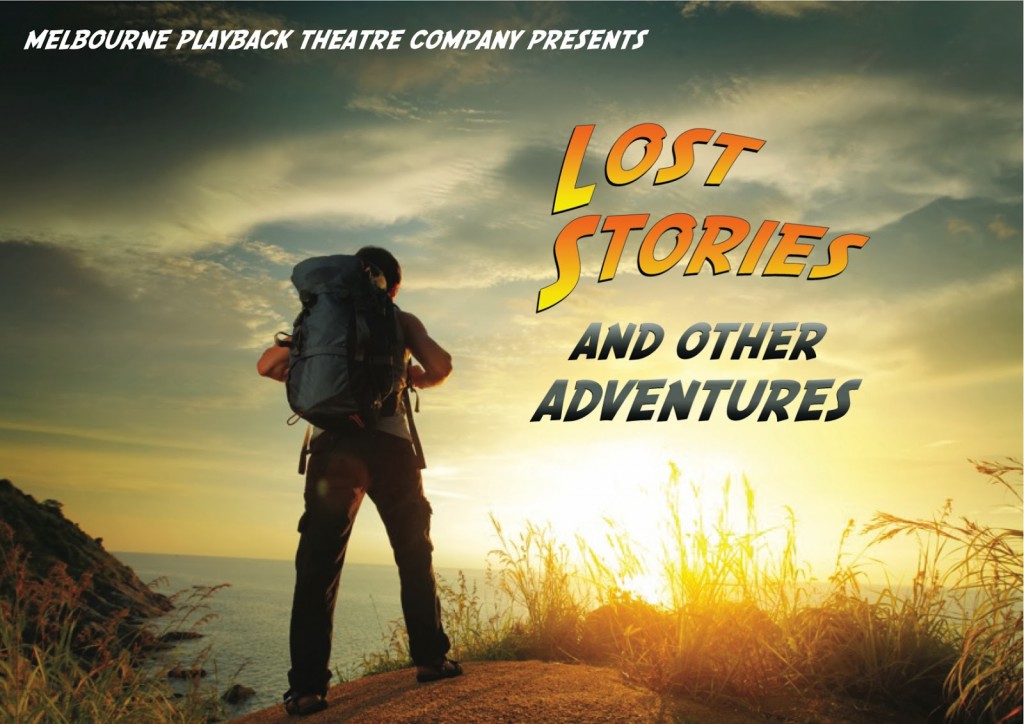
Chance encounters, mysterious strangers and chats at the coffee machine. The challenges and triumphs, the heroes and villains, this is your year on stage. Uncover forgotten moments and celebrate your year with Melbourne Playback.
This is what the audience had to say from performances recently held at the Beckett Theatre, the Coopers Malthouse.
“I love the way you honour people’s stories – what is said and what is unsaid. I feel enlivened – not only as I consider the process and synchronicity of the performance, but as I consider the emotions captured and expressed. Thank you :)”
Janine
“It was the most amazing & gripping & wonderful journey! For some unknown reason I had tears rolling down my cheeks at times, and laughed a lot at other times.”
Freda
“Amazed at actor’s improvising skills and ability to quickly determine the means by which they expressed the ‘Lost Stories’.”
Jim
“I really enjoyed the integrity the cast have with sharing stories from the audience. The truth and generosity is really rewarding from an audience perspective.”
Lorna
“I Loved it! Amazing – my stories were there and I didn’t say a word.”
Carlina
“Fun, different, entertaining, enlightening! and special. Eye-opening to hear different people’s stories.”
Anon
Thank you everyone for coming…
Melbourne Playback Theatre Company presents:
The Little Things
Those little things caught in your memory, that make you catch your breath, cause your heart to warm or keep you smiling even after you’ve walked away. The things perhaps too small even for an anecdote but are the essence of your personal story. This is a celebration of those little things. They make a big difference after all.
The Melbourne Playback Ensemble is Rodney Afif, Karen Berger, Ian David, Alan Davies, Danny Diesendorf, Rachael Dyson-McGregor, Andrew Gray, Sherridan Green, Ernie Gruner, Petra Kalive, Allen Laverty, Mike McEvoy, Diana Nguyen, Michelle Nussey, Alex Sangster, Emily Taylor.
Dates & Times
October – Saturday 12 at 8pm and Sunday 13 at 6pm
Tickets Full $25 Concession $15
La Mama, 205 Faraday St, Carlton
BUY TICKETS
Posted by Sheridan Green in
Tips on 26 Jul 2013
Playback Theatre is a form of theatre that encourages a high level of communication between all involved. The facilitator / conductor, the performers and the audience are all engaged in deep listening and because the performers are modelling empathic and active listening techniques, they encourage empathy between audience and storyteller.
Our ensemble have brainstormed ten communication tips derived from their experience listening and reflecting thousands of stories. The 10 tips below all apply as much in everyday communication as they do in Playback Theatre.
In Playback the performers do not ask questions, they listen to the whole story and they imagine themselves in the storyteller’s shoes before responding. It is the facilitator’s job to ask questions, but also to get out of the way and let the storyteller tell the story that they want to share.
- Listen to understand first, then to be understood.
- Remember you have only one mouth and two ears for a reason. Listen more than you speak.
- Listen to the speaker rather than listening for your own response.
- Remember the power of stillness and pause.
- There’s no harm done speaking a little slower.
- Learn people’s names and use them when you speak with them.
- Ask questions, get to know people by asking them about themselves. Be interested in what they say and see if you can find common ground.
- Let people finish. It’s hard to stop yourself when you have a good idea, but it can be great to hold that thought and let the person finish. What they finish with might change how you respond.
- Put your phone away when talking. Give your full attention.
- Not all cultures use direct eye contact.
Thank you to every one who attended Playback’s Theatre Works Season.
A special thanks to the audience members who shared their stories.
Feedback from some of the audience:
“I always love it. So much tension every time. Beautiful actors.”
“Don’t think it could of been better.”
“Good giggles. Comfortable, easy, relaxed evening.”
“The honesty of the stories and the quality of the interpretation was inspiring.”
“Loved the positive spin on some sad stories.”
“I liked the involvement of the audience and the accurate take the performers had on the stories.”
“Emotional. Engaging. Excellent.”
“The musicians were fantastic and really worked well with the improvisation.”
“Very engaging, thoroughly entertaining. The ensemble are very talented.”
“Validating, moved, honouring, vulnerable, thank you.”
“The best I have seen – the diverse theatrical skills used was excellent.”
“I liked the supportive environment created for the audience member telling the story.”
“Great, very creative, actors were excellent and versatile.”
Posted by Sheridan Green in
News on 28 Jun 2013
Melbourne Playback is looking forward to seeing you at our Portraits Public Shows this weekend at Theatre Works. Saturday 29 at 8pm and Sunday 30 at 6pm.
Come along and watch audience members stories come to life through theatre.
Or you may have a story to tell?
Meet company members in the foyer post the performance.
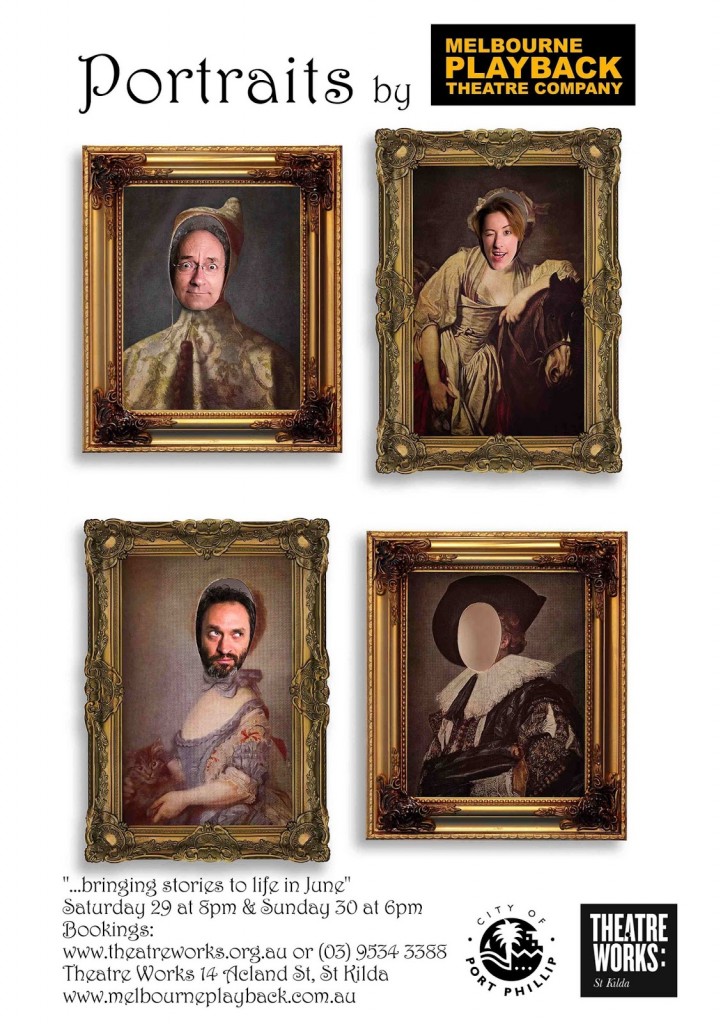
![KeepCalmStudio.com-[Crown]-Keep-Calm-And-Use-Your-Soft-Skills (1)](http://melbourneplayback.com.au/cms/wp-content/uploads/2015/04/KeepCalmStudio.com-Crown-Keep-Calm-And-Use-Your-Soft-Skills-1-e1428358874358.png)







